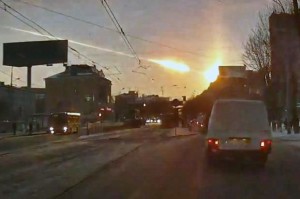10,000 Near Earth Objects, and a Pleasantly More Assertive NASA
On June 18, 2013, Asteroid 2013 MZ5 was originally detected, and by June 24, it was officially identified as the 10,000th Near Earth Object (NEO – asteroids and comets whose orbits approach or cross Earth’s orbit) to be discovered. Asteroid 2013 MZ5 is approximately 1,000 feet (300 meters) across. Its orbit is well understood, and it will not approach close enough to Earth to be considered potentially hazardous. Although 10,000 NEOs may seem to be a huge number, less than 1% of NEOs believed to be 100 feet or larger (large enough to “cause significant devastation” according to NASA) have been detected. How significant would the devastation be from a 100 foot Near Earth Asteroid (NEA)? Imagine a 100 foot NEA striking a city with a population of millions, and leaving a crater where that entire city used to be. That certainly qualifies as significant devastation.
 The February 15 NEA airburst over Chelyabinsk, Russia (which injured approximately 1,000 people), brought worldwide media attention to that NEA, if only for that weekend. Since then, NASA has increased its efforts to request from the U.S. Congress the additional funding needed to identify and categorize NEOs. (Since there are believed to be considerably more NEAs than near Earth comets, the term NEA tends to be more commonplace.) Time will tell if that additional funding is approved.
The February 15 NEA airburst over Chelyabinsk, Russia (which injured approximately 1,000 people), brought worldwide media attention to that NEA, if only for that weekend. Since then, NASA has increased its efforts to request from the U.S. Congress the additional funding needed to identify and categorize NEOs. (Since there are believed to be considerably more NEAs than near Earth comets, the term NEA tends to be more commonplace.) Time will tell if that additional funding is approved.
Although it has not qualified as “breaking news” – but perhaps it should have – NASA has recently proposed a significant change to the flight plan of the Space Launch System (SLS) Block I debut, known as Exploration Mission-1 (EM-1), scheduled to launch in 2017. The original plan was to have the SLS Block I launch an uncrewed Orion Multi-Purpose Crew Vehicle (MPCV) to orbit the Moon and return to Earth, with a mission duration of 7-10 days. By contrast, the recent proposal would have that SLS Block I launch the uncrewed Orion MPCV to over 40,000 miles beyond the Moon’s orbit, to Earth-Moon Lagrange Point #2 (EML-2), with a mission duration of 25 days. The proposed changes would be in preparation for EM-2, which would be another SLS Block I launching a crewed Orion MPCV in 2021 to rendezvous with a yet-to-be-identified approximately 22 foot-wide Near Earth Asteroid (NEA), which would have been captured and redirected to EML-2 during NASA’s proposed Asteroid Redirect Mission in approximately 2019. Those EM-2 astronauts would place pristine NEA samples in sealed containers, then return those samples to the Earth for extensive lab analyses.
What about that NEA remaining in EML-2, beyond the Moon? Depending on its composition, perhaps one of the new NEA mining companies could extract metals, minerals, hydrocarbons, and/or water ice from that NEA, then sell it, creating humanity’s first naturally-occurring source of revenue in space. Reaching EML-2 uses less energy than reaching and landing on the Moon, so mining that NEA would have at least one advantage over mining the Moon.
With approval of the changes to EM-1 and EM-2 for the Space Launch System, NASA would be able to test, verify, and upgrade an assortment of new technologies – and NASA provides its findings free to the public. The knowledge gained from EM-1 and EM-2 would benefit NASA’s eventual missions to rendezvous with NEAs in their natural orbits later in the 2020’s, and on to Mars and its moons by the 2030’s. Additionally, the information will also benefit those Commercial Spaceflight companies which intend to mine NEAs for its materials, and those other Commercial Spaceflight companies which intend to go to Mars and/or its moons (unless they have already made the Martian journey before 2021.) We truly live in interesting times!
Ken Ruffin is the chapter president of the National Space Society (NSS) of North Texas, which supports Science, Technology, Engineering, and Math (STEM) education, and space science and space development, throughout the Dallas-Ft. Worth (DFW) metro area and beyond. Additionally, Ken has been a Trekkie since 1974.
For more information in the Dallas-Ft. Worth metro area, go to http://www.nssofnt.org/, and consider attending a NSSNT chapter meeting!



















 Full Details
Full Details



No comments yet.
Sorry, the comment form is closed at this time.